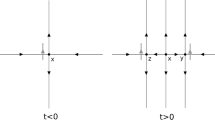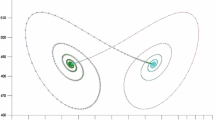Abstract
To make progress toward better computability of Morse–Floer homology and thus enhance the applicability of Floer theory, it is essential to have tools to determine the relative index of equilibria. Since even the existence of nontrivial stationary points is often difficult to accomplish, extracting their index information is usually out of reach. In this paper, we establish a computer-assisted proof approach to determining relative indices of stationary states. We introduce the general framework and then focus on three example problems described by partial differential equations to show how these ideas work in practice. Based on a rigorous implementation, with accompanying code made available, we determine the relative indices of many stationary points. Moreover, we show how forcing results can be then used to prove theorems about connecting orbits and traveling waves in partial differential equations.




Similar content being viewed by others
References
S. Angenent and R. Vandervorst. A superquadratic indefinite elliptic system and its Morse–Conley–Floer homology. Math. Z., 231(2):203–248, 1999.
N. Aronszajn. A unique continuation theorem for solutions of elliptic partial differential equations or inequalities of second order. J. Math. Pures Appl. (9), 36:235–249, 1957.
M. P. Bahiana. Cell dynamical system approach to block copolymers. ProQuest LLC, Ann Arbor, MI, 1990. Thesis (Ph.D.)–University of Illinois at Urbana-Champaign.
B. Bakker, J. B. van den Berg, and R. Vandervorst. A Floer homology approach to traveling waves in reaction–diffusion equations on cylinders. SIAM J. Appl. Dyn. Syst., 17(4):2634–2706, 2018.
B. Breuer, J. Horák, P. J. McKenna, and M. Plum. A computer-assisted existence and multiplicity proof for travelling waves in a nonlinearly supported beam. J. Differential Equations, 224(1):60–97, 2006.
B. Breuer, P. J. McKenna, and M. Plum. Multiple solutions for a semilinear boundary value problem: a computational multiplicity proof. J. Differential Equations, 195(1):243–269, 2003.
R. Castelli and J.-P. Lessard. A method to rigorously enclose eigenpairs of complex interval matrices. In Applications of mathematics 2013, pages 21–31. Acad. Sci. Czech Repub. Inst. Math., Prague, 2013.
R. Choksi, M. A. Peletier, and J. F. Williams. On the phase diagram for microphase separation of diblock copolymers: an approach via a nonlocal Cahn–Hilliard functional. SIAM J. Appl. Math., 69(6):1712–1738, 2009.
J. Cyranka and T. Wanner. Computer-assisted proof of heteroclinic connections in the one-dimensional Ohta–Kawasaki Model. SIAM J. Appl. Dyn. Syst., 17(1):694–731, 2018.
S. Day, Y. Hiraoka, K. Mischaikow, and T. Ogawa. Rigorous numerics for global dynamics: a study of the Swift-Hohenberg equation. SIAM J. Appl. Dyn. Syst., 4(1):1–31 (electronic), 2005.
S. Day, J.-P. Lessard, and K. Mischaikow. Validated continuation for equilibria of PDEs. SIAM J. Numer. Anal., 45(4):1398–1424 (electronic), 2007.
R. de la Llave and J. D. Mireles James. Connecting orbits for compact infinite dimensional maps: computer assisted proofs of existence. SIAM J. Appl. Dyn. Syst., 15(2):1268–1323, 2016.
B. Fiedler, A. Scheel, and M. I. Vishik. Large patterns of elliptic systems in infinite cylinders. J. Math. Pures Appl. (9), 77(9):879–907, 1998.
A. Floer. Morse theory for Lagrangian intersections. J. Differential Geom., 28(3):513–547, 1988.
A. Floer. Symplectic fixed points and holomorphic spheres. Comm. Math. Phys., 120(4):575–611, 1989.
R. Gardner. Existence of multidimensional travelling wave solutions of an initial-boundary value problem. J. Differential Equations, 61(3):335–379, 1986.
J. Gómez-Serrano. Computer-assisted proofs in PDE: a survey. SeMA J., 76(3):459–484, 2019.
D. B. Henry. Some infinite-dimensional Morse–Smale systems defined by parabolic partial differential equations. J. Differential Equations, 59(2):165–205, 1985.
A. Hungria, J.-P. Lessard, and J. D. Mireles James. Rigorous numerics for analytic solutions of differential equations: the radii polynomial approach. Math. Comp., 85(299):1427–1459, 2016.
W. D. Kalies, K. Mischaikow, and R. C. A. M. Vandervorst. Lattice structures for attractors I. J. Comput. Dyn., 1(2):307–338, 2014.
W. D. Kalies, K. Mischaikow, and R. C. A. M. Vandervorst. Lattice structures for attractors III. J. Dynam. Differential Equations, 2021.
H. Koch, A. Schenkel, and P. Wittwer. Computer-assisted proofs in analysis and programming in logic: a case study. SIAM Rev., 38(4):565–604, 1996.
J.-P. Lessard and J. D. Mireles James. Computer assisted Fourier analysis in sequence spaces of varying regularity. SIAM J. Math. Anal., 49(1):530–561, 2017.
A. Mielke. Essential manifolds for an elliptic problem in an infinite strip. J. Differential Equations, 110(2):322–355, 1994.
J. D. Mireles James and K. Mischaikow. Computational proofs in dynamics. In B. Engquist, editor, Encyclopedia of Applied and Computational Mathematics, pages 288–295. Springer, 2015.
K. Mischaikow. Global asymptotic dynamics of gradient-like bistable equations. SIAM J. Math. Anal., 26(5):1199–1224, 1995.
R. E. Moore. Interval analysis. Prentice-Hall Inc., Englewood Cliffs, N.J., 1966.
M. T. Nakao, M. Plum, and Y. Watanabe. Numerical verification methods and computer-assisted proofs for partial differential equations, volume 53 of Springer Series in Computational Mathematics. Springer, Singapore, 2019.
Y. Nishiura and I. Ohnishi. Some mathematical aspects of the micro-phase separation in diblock copolymers. Phys. D, 84(1-2):31–39, 1995.
T. Ohta and K. Kawasaki. Equilibrium morphology of block copolymer melts. Macromolecules, 19:2621–2632, 1986.
J. Robbin and D. Salamon. The spectral flow and the Maslov index. Bull. London Math. Soc., 27(1):1–33, 1995.
S. Rump. INTLAB - INTerval LABoratory. In T. Csendes, editor, Developments in Reliable Computing, pages 77–104. Kluwer Academic Publishers, Dordrecht, 1999. http://www.ti3.tu-harburg.de/rump/.
S. M. Rump. Verification methods: rigorous results using floating-point arithmetic. Acta Numer., 19:287–449, 2010.
D. Salamon. Morse theory, the Conley index and Floer homology. Bull. London Math. Soc., 22(2):113–140, 1990.
D. Salamon and E. Zehnder. Floer homology, the Maslov index and periodic orbits of Hamiltonian equations. pages 573–600, 1990.
D. Salamon and E. Zehnder. Morse theory for periodic solutions of Hamiltonian systems and the Maslov index. Comm. Pure Appl. Math., 45(10):1303–1360, 1992.
D. A. Salamon and J. Weber. Floer homology and the heat flow. Geom. Funct. Anal., 16(5):1050–1138, 2006.
M. Schwarz. Morse homology, volume 111 of Progress in Mathematics. Birkhäuser Verlag, Basel, 1993.
S. Smale. Differentiable dynamical systems. Bull. Amer. Math. Soc., 73:747–817, 1967.
R. Thom. Sur une partition en cellules associée à une fonction sur une variété. C. R. Acad. Sci. Paris, 228:973–975, 1949.
W. Tucker. Validated numerics. Princeton University Press, Princeton, NJ, 2011. A short introduction to rigorous computations.
J. B. van den Berg, M. Gameiro, J.-P. Lessard, and R. C. Vandervorst. http://www.math.mcgill.ca/jplessard/ResearchProjects/RelativeInd/home.html. MATLAB codes to perform the proofs, 2022.
J. B. van den Berg, R. Ghrist, R. C. Vandervorst, and W. Wójcik. Braid Floer homology. J. Differential Equations, 259(5):1663–1721, 2015.
J. B. van den Berg and J.-P. Lessard. Chaotic braided solutions via rigorous numerics: chaos in the Swift-Hohenberg equation. SIAM J. Appl. Dyn. Syst., 7(3):988–1031, 2008.
J. B. van den Berg and J.-P. Lessard. Rigorous numerics in dynamics. Notices of the American Mathematical Society, 62(9):1057–1061, 2015.
J. B. van den Berg and J. F. Williams. Validation of the bifurcation diagram in the 2D Ohta–Kawasaki problem. Nonlinearity, 30(4):1584–1638, 2017.
J. B. van den Berg and J. F. Williams. Optimal periodic structures with general space group symmetries in the Ohta–Kawasaki problem. Phys. D, 415:Paper No. 132732, 23, 2021.
Y. Watanabe, M. Plum, and M. T. Nakao. A computer-assisted instability proof for the Orr–Sommerfeld problem with Poiseuille flow. ZAMM Z. Angew. Math. Mech., 89(1):5–18, 2009.
J. Weber. Morse homology for the heat flow. Math. Z., 275(1-2):1–54, 2013.
E. Witten. Supersymmetry and Morse theory. J. Differential Geom., 17(4):661–692, 1982.
Author information
Authors and Affiliations
Corresponding author
Additional information
Communicated by Peter Bubenik.
Publisher's Note
Springer Nature remains neutral with regard to jurisdictional claims in published maps and institutional affiliations.
Rights and permissions
Springer Nature or its licensor (e.g. a society or other partner) holds exclusive rights to this article under a publishing agreement with the author(s) or other rightsholder(s); author self-archiving of the accepted manuscript version of this article is solely governed by the terms of such publishing agreement and applicable law.
About this article
Cite this article
van den Berg, J.B., Gameiro, M., Lessard, JP. et al. Toward Computational Morse–Floer Homology: Forcing Results for Connecting Orbits by Computing Relative Indices of Critical Points. Found Comput Math (2023). https://doi.org/10.1007/s10208-023-09623-w
Received:
Revised:
Accepted:
Published:
DOI: https://doi.org/10.1007/s10208-023-09623-w
Keywords
- Floer homology
- Relative indices
- Ill-posed PDEs
- Strongly indefinite problems equilibrium solutions
- Connecting orbits
- Forcing theorems
- Computer-assisted proofs




